Creating moss gardens transforms any space into a peaceful, low-maintenance oasis that thrives in conditions where traditional plants struggle. These ancient plants, which have flourished for over 400 million years, offer endless design possibilities from Japanese zen retreats to modern vertical installations. Moss gardens require minimal upkeep while providing year-round beauty through their rich textures and vibrant green hues. Whether designing intimate terrarium worlds or expansive outdoor landscapes, moss serves as nature's carpet, softening harsh elements and creating tranquil environments. The versatility of moss allows for both indoor and outdoor applications, making it perfect for urban settings, shaded yards, and creative container designs that bring natural serenity to any environment.
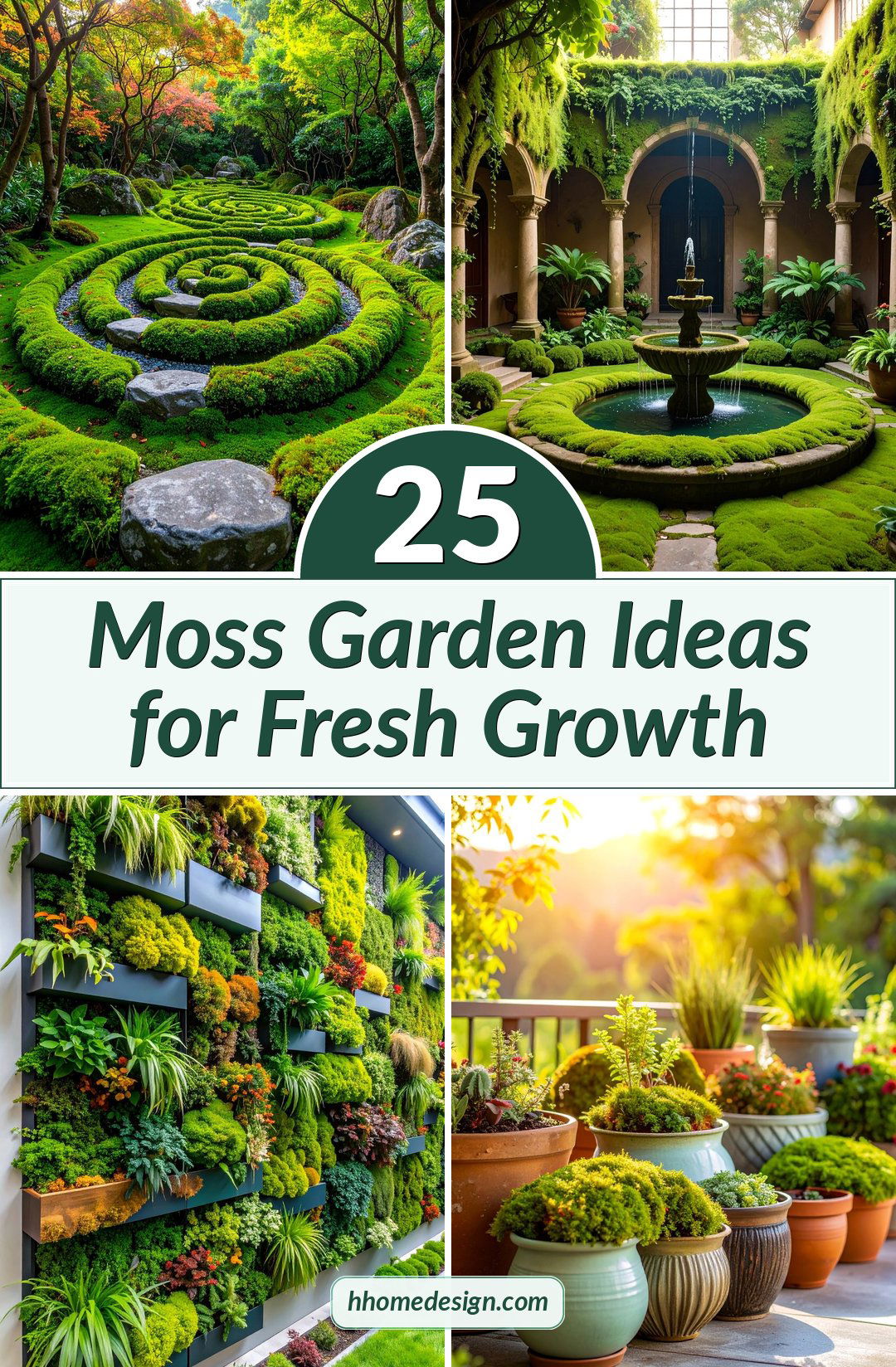
1. Japanese Zen Moss Garden with Stone Arrangements

Traditional Japanese zen gardens featuring moss create the ultimate meditation space through carefully balanced stone placements and lush green carpets. Ancient design principles guide the placement of weathered rocks in odd-numbered groupings, surrounded by velvety moss that represents islands in a sea of tranquility. The moss softens the stark mineral elements while providing year-round color that deepens with seasonal moisture changes. Stone pathways wind through moss-covered areas, encouraging slow, mindful movement through the space. This design emphasizes negative space and asymmetrical balance, with moss serving as the unifying element that connects all hardscape features. Regular misting maintains the moss while the stones require occasional repositioning to prevent settling, creating an evolving landscape that changes subtly over time.
2. Moss Terrarium Woodland Miniature Landscape
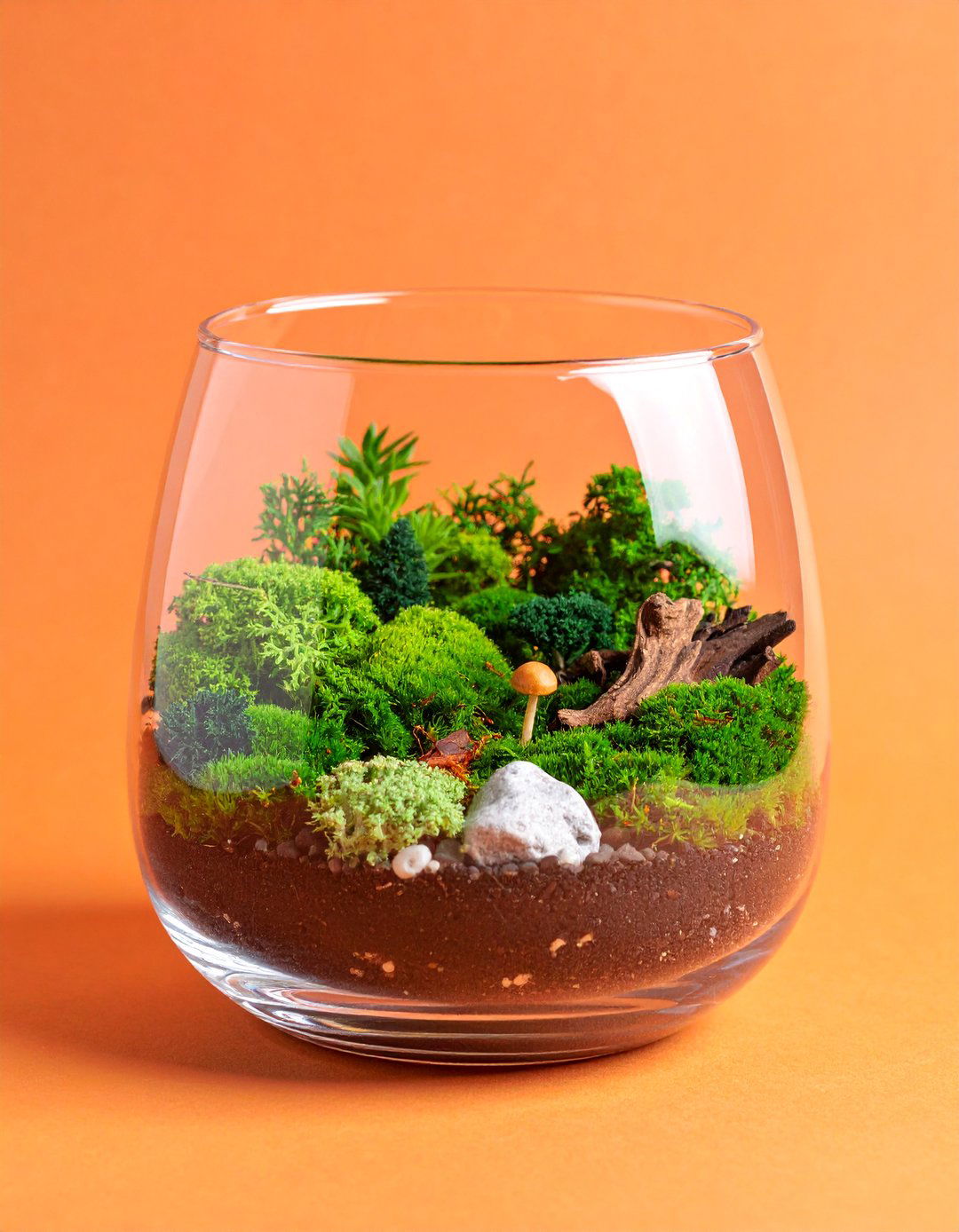
Indoor moss terrariums recreate enchanting woodland scenes within glass containers, featuring rolling hills of cushion moss punctuated by miniature trees and decorative elements. Multiple moss varieties create textural depth, with sheet moss forming flat meadows while mood moss adds height and wild character. Tiny figurines, crystals, or driftwood pieces enhance the magical forest atmosphere without overwhelming the natural beauty. The enclosed environment maintains perfect humidity levels for moss while creating a living artwork that requires minimal maintenance. Strategic placement of hardscape elements guides the eye through different viewing angles, revealing hidden details and creating depth within the confined space. This design works perfectly for offices, bedrooms, or any indoor space needing a touch of nature.
3. Moss Rock Garden with Natural Stone Pathways
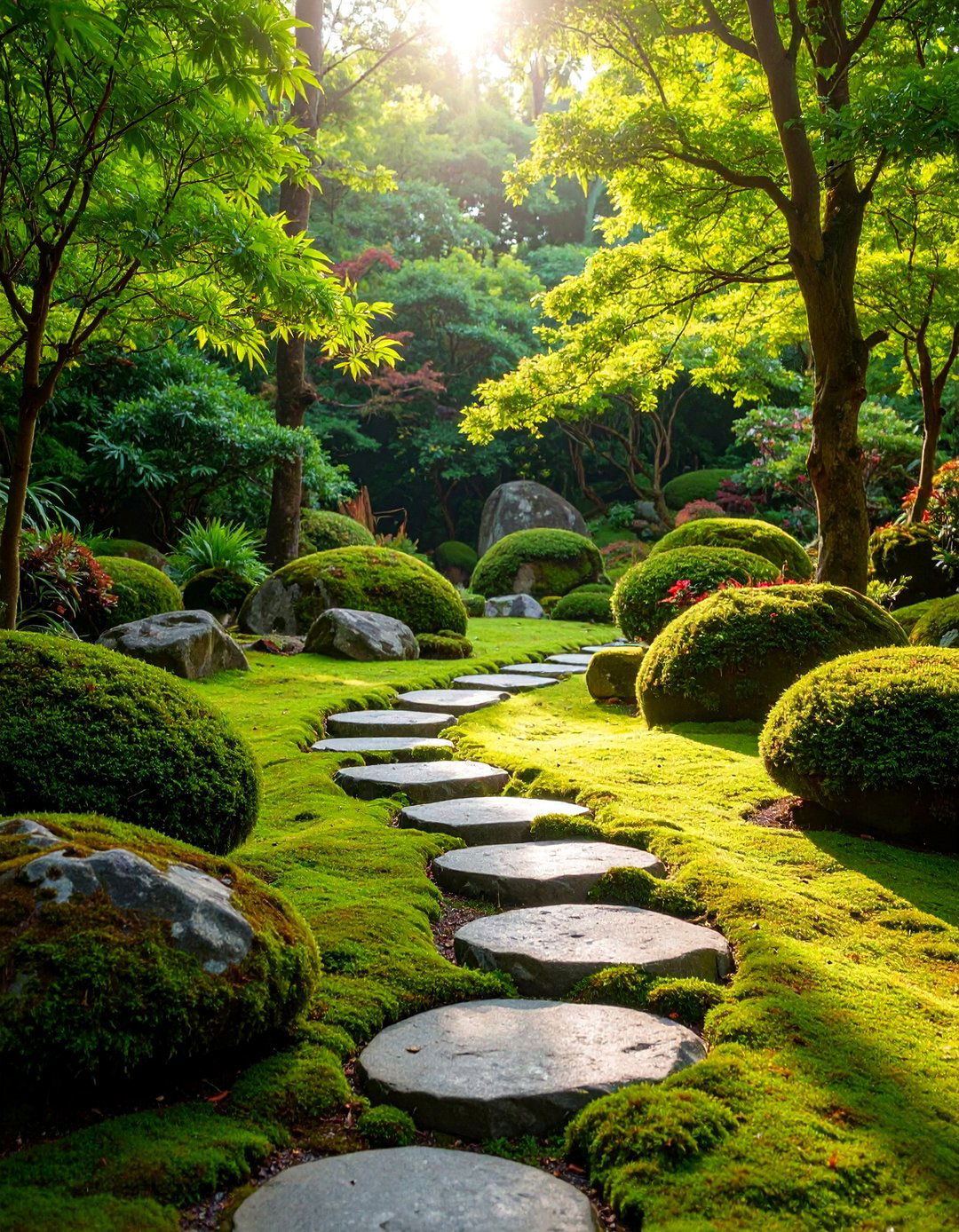
Moss-covered rock gardens blend rugged natural beauty with soft organic textures, creating dramatic landscapes perfect for sloped or challenging terrain. Large boulders become moss-draped sculptures while smaller stones form naturalistic pathways that seem to emerge organically from the earth. Different moss varieties colonize various surfaces, with rock cap moss thriving on stone surfaces and sheet moss spreading across soil areas. The interplay between hard stone and soft moss creates visual contrast while the pathways provide practical navigation through the garden. Water naturally pools in rock crevices, creating perfect microenvironments for moss establishment and growth. This low-maintenance design works beautifully in both formal and naturalistic garden settings.
4. Vertical Moss Wall Garden for Indoor Spaces
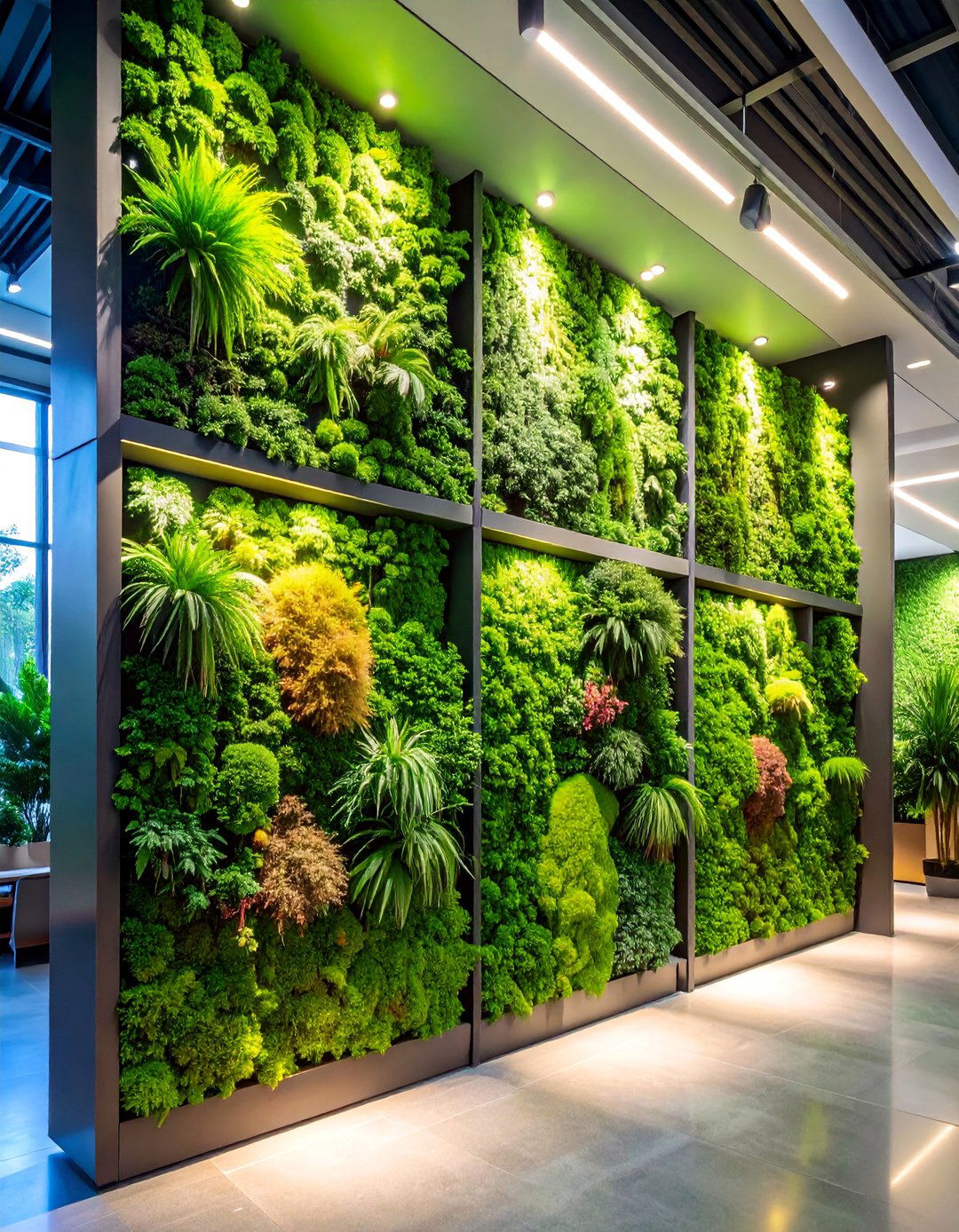
Living moss walls bring nature indoors through vertical installations that serve as stunning focal points while improving air quality and acoustics. Preserved moss varieties in multiple shades of green create artistic patterns and textures without requiring water or sunlight. The installation process involves securing moss panels to wall-mounted frames, allowing for custom shapes, company logos, or abstract designs. Sound-absorbing properties make these walls perfect for offices, restaurants, or homes where noise reduction is desired. Different moss textures create visual interest, from the fine, feathery appearance of sheet moss to the cushioned luxury of reindeer moss. These installations require no maintenance once established, making them ideal for busy commercial or residential environments.
5. Moss Carpet Lawn Alternative Garden
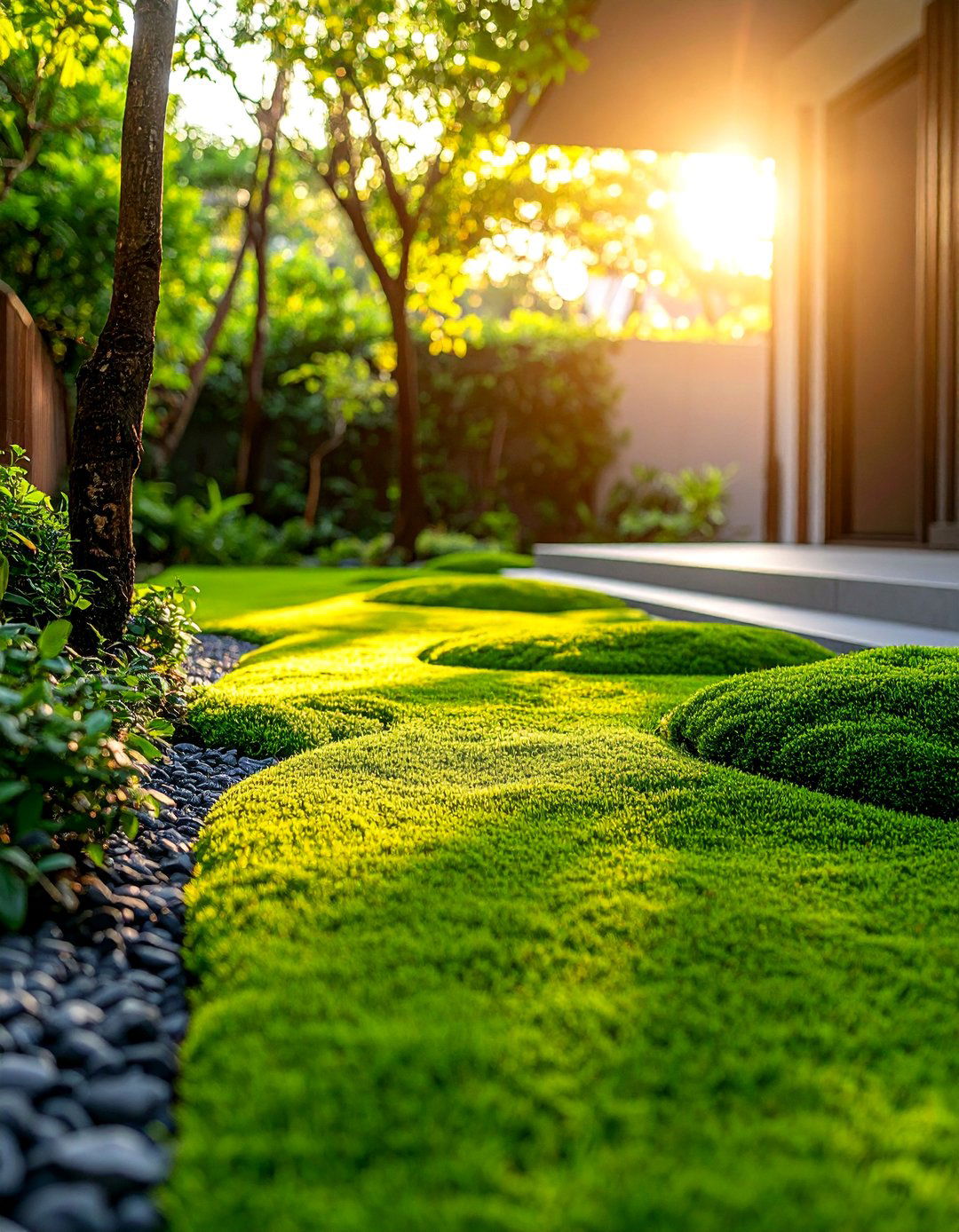
Moss lawns provide sustainable alternatives to traditional grass, requiring no mowing, fertilizing, or frequent watering while creating soft, walkable surfaces. Sheet moss and other creeping varieties spread naturally to form dense carpets that remain green through drought and cold conditions. The installation involves clearing existing vegetation, adjusting soil pH to slightly acidic levels, and transplanting moss patches that gradually expand to cover the area. This design works exceptionally well in shaded areas where grass struggles, creating lush green spaces that support foot traffic and provide cooling effects. Seasonal leaf removal and occasional weeding represent the only maintenance requirements. The result is an eco-friendly landscape that reduces environmental impact while providing year-round beauty.
6. Moss Water Feature Garden with Pond Edges

Moss gardens surrounding water features create seamless transitions between aquatic and terrestrial environments, enhancing the natural appearance of ponds, streams, or fountains. The moss thrives in the humid conditions near water while softening hard edges of stone or concrete water feature construction. Strategic moss placement on rocks and pond edges creates the illusion of ancient, naturally evolved landscapes. Stepping stones through moss areas provide access for maintenance while preserving the moss carpet integrity. The sound of water combined with the visual softness of moss creates deeply calming environments perfect for meditation or relaxation. This design requires attention to moisture balance, ensuring moss receives adequate humidity without becoming waterlogged.
7. Fairy Garden Moss Landscape with Miniature Accessories
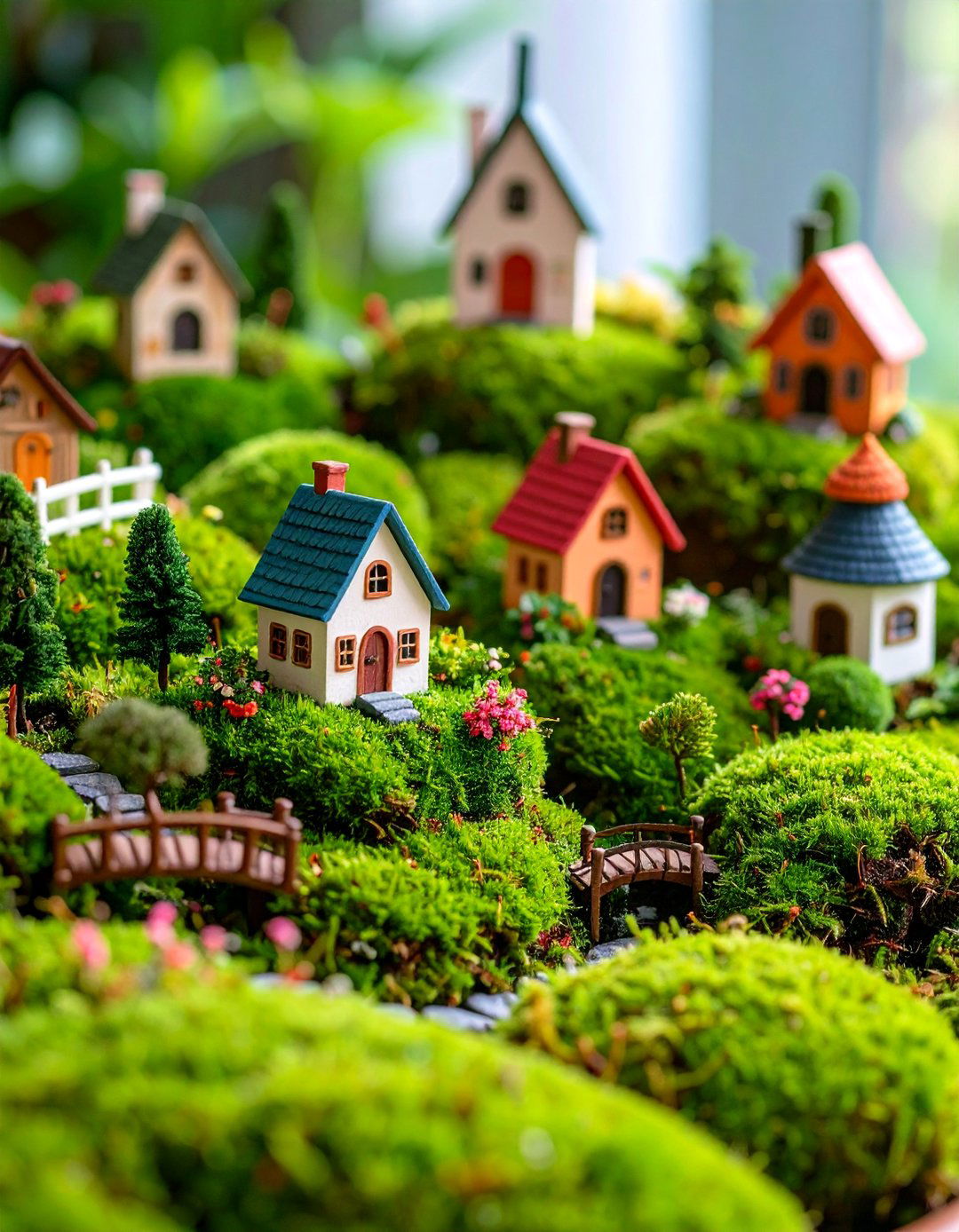
Whimsical fairy gardens use moss as the foundation for magical miniature worlds filled with tiny houses, bridges, and pathways that spark imagination. Carpet moss creates perfect fairy lawns while cushion moss forms rolling hills where miniature dwellings nestle naturally. Small accessories like pebble pathways, twig furniture, and tiny lanterns enhance the enchanted atmosphere without overwhelming the natural moss beauty. These gardens work wonderfully in containers, raised beds, or corner garden spaces where children can engage with nature through storytelling and imagination. The moss provides a living backdrop that changes seasonally while maintaining the magical atmosphere year-round. Regular misting keeps moss healthy while occasional accessory updates maintain interest and engagement.
8. Moss Stepping Stone Pathway Garden
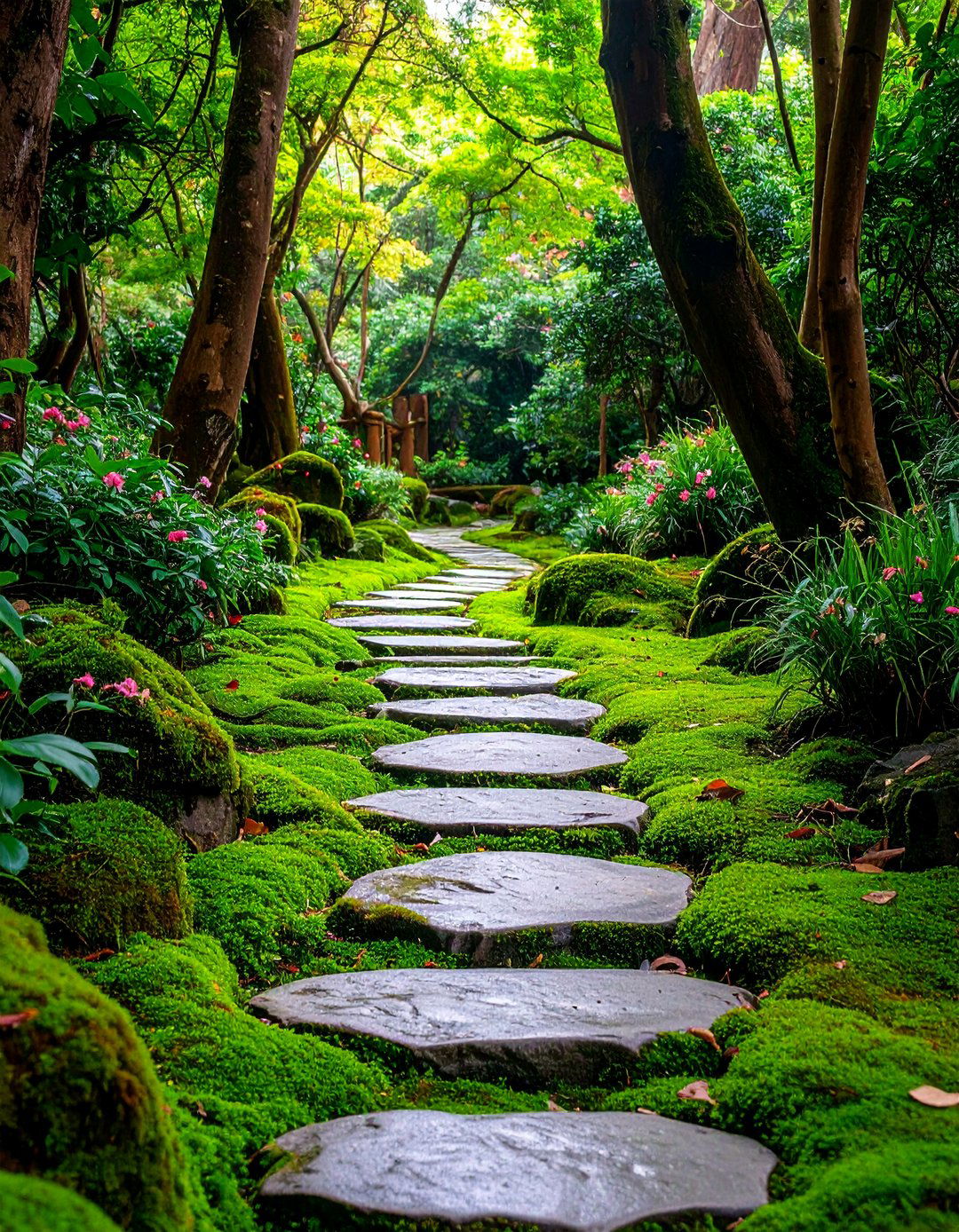
Moss-filled pathways using stepping stones create meandering routes through gardens while protecting moss from foot traffic damage. Natural stone or concrete pavers provide stable walking surfaces while moss fills the spaces between, softening the pathway and integrating it with surrounding landscapes. The design allows moss to spread naturally while directing foot traffic along designated routes, protecting larger moss areas from damage. Different moss varieties can create patterns or color variations between stones, adding visual interest to functional pathways. This approach works well in shade gardens, woodland settings, or any area where traditional grass pathways would struggle. Installation involves careful stone placement and moss establishment, followed by minimal maintenance once the moss establishes itself.
9. Moss Shade Garden with Fern Companions
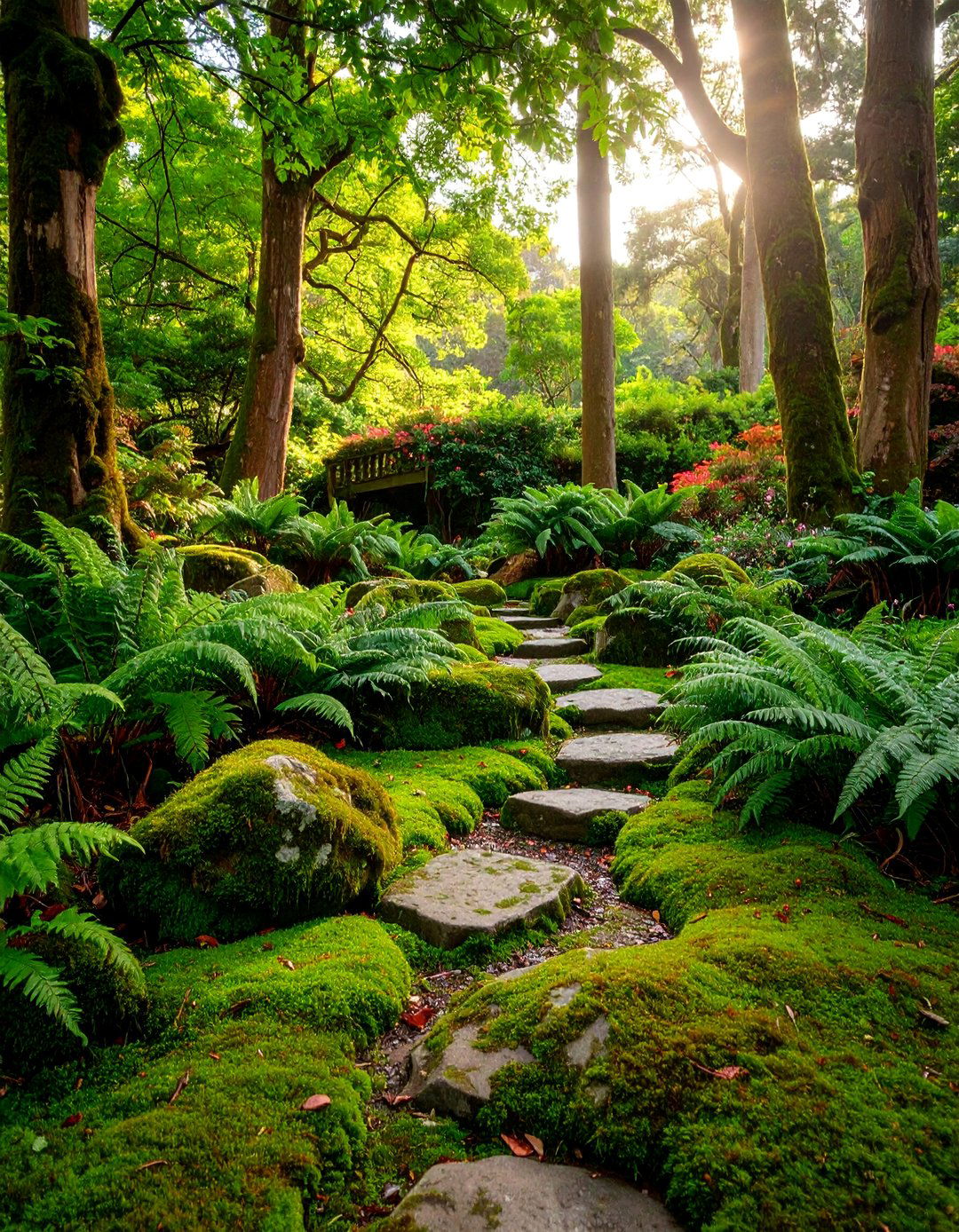
Shade gardens combining moss with ferns create lush, layered landscapes that thrive in low-light conditions where other plants fail. The moss provides ground-level interest while ferns add height and textural contrast with their delicate fronds. This partnership creates natural woodland atmospheres perfect for shaded courtyards, under-tree areas, or north-facing garden spaces. Different moss varieties create varying textures and heights, from flat sheet moss to mounded cushion moss, while ferns provide vertical elements and seasonal interest. The combination requires similar growing conditions, making maintenance straightforward with occasional watering during dry periods. These gardens feel established and mature immediately after installation, creating instant woodland charm in urban or suburban settings.
10. Moss Art Installation Garden with Geometric Patterns

Contemporary moss gardens featuring geometric patterns transform outdoor spaces into living art installations that blend nature with modern design principles. Precise moss placement creates squares, circles, or abstract shapes that contrast beautifully with naturalistic surrounding plantings. This design approach works particularly well in formal garden settings, courtyards, or areas where architecture and nature intersect. Different moss varieties provide color and texture variations within the geometric framework, creating subtle patterns that change with seasonal growth cycles. Installation requires careful planning and precision placement, but maintenance remains minimal once patterns establish. These installations demonstrate moss versatility beyond traditional naturalistic applications, proving its effectiveness in contemporary landscape design.
11. Moss Container Garden Collection with Varied Vessels
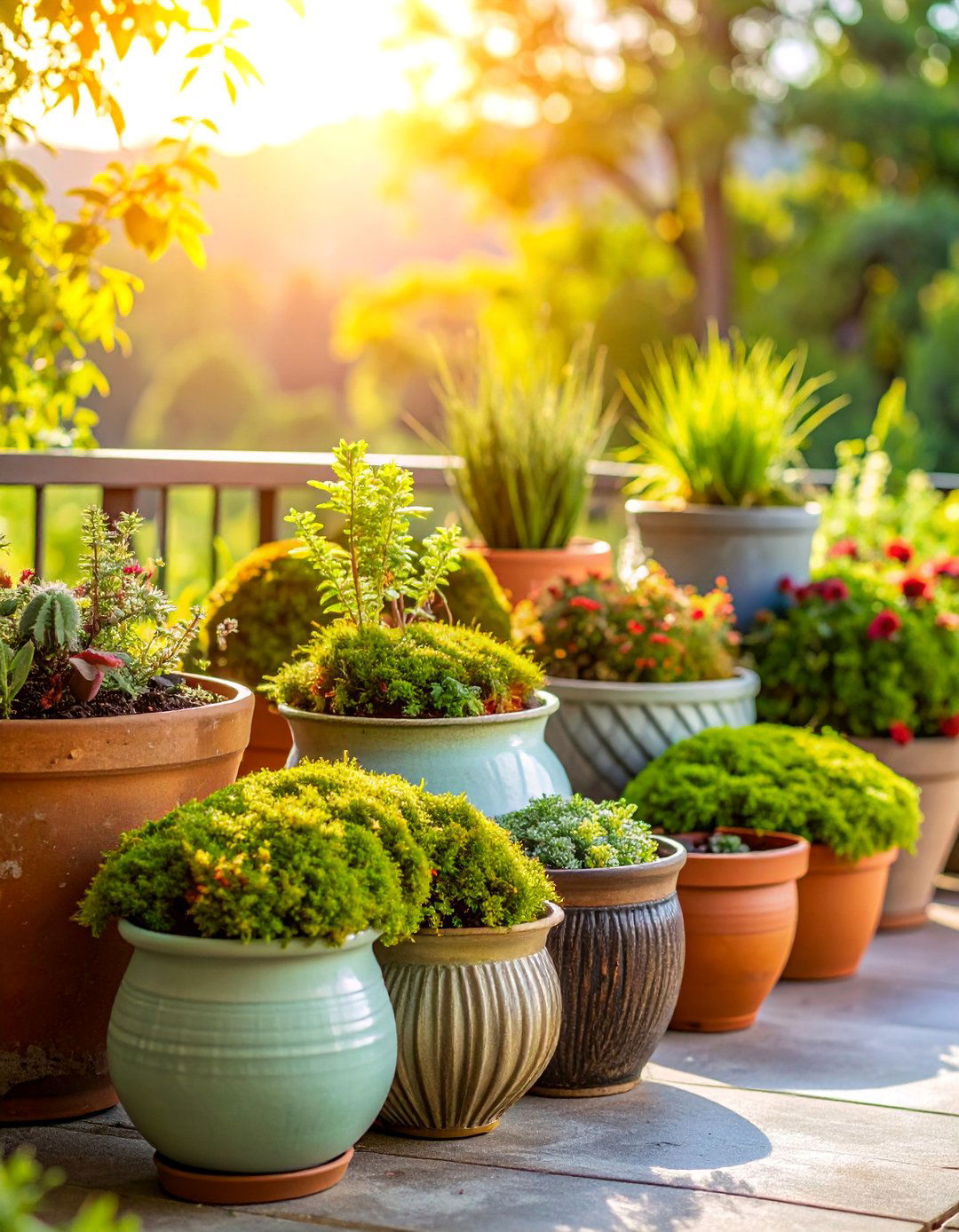
Multiple moss containers create portable garden collections perfect for patios, balconies, or indoor spaces where traditional gardens aren't possible. Different vessel shapes, sizes, and materials showcase moss versatility while allowing easy arrangement changes based on seasons or design preferences. Terra cotta pots, wooden boxes, glass bowls, and metal containers each create different aesthetic effects while supporting moss growth through proper drainage and moisture retention. This approach allows experimentation with moss varieties, companion plants, and design themes without permanent landscape commitment. Containers can be grouped for maximum impact or distributed throughout spaces for subtle natural accents. The portability enables protection during extreme weather while maintaining garden interest year-round.
12. Moss Meditation Circle Garden with Seating Area

Circular moss gardens with central seating create dedicated meditation spaces that encourage contemplation and connection with nature. The circular design focuses energy inward while moss carpeting provides visual calm and sound absorption for enhanced meditation experiences. Natural stone or wooden benches integrate seamlessly with moss surroundings, creating comfortable spaces for extended sitting without disturbing the moss ecosystem. The design incorporates subtle pathways for access while protecting the majority of moss from foot traffic. Surrounding plants or landscape features create privacy and enclosure, enhancing the sense of retreat from daily stresses. This therapeutic garden design supports mental wellness while requiring minimal maintenance beyond basic moss care.
13. Moss Living Wall Vertical Garden with Drainage System
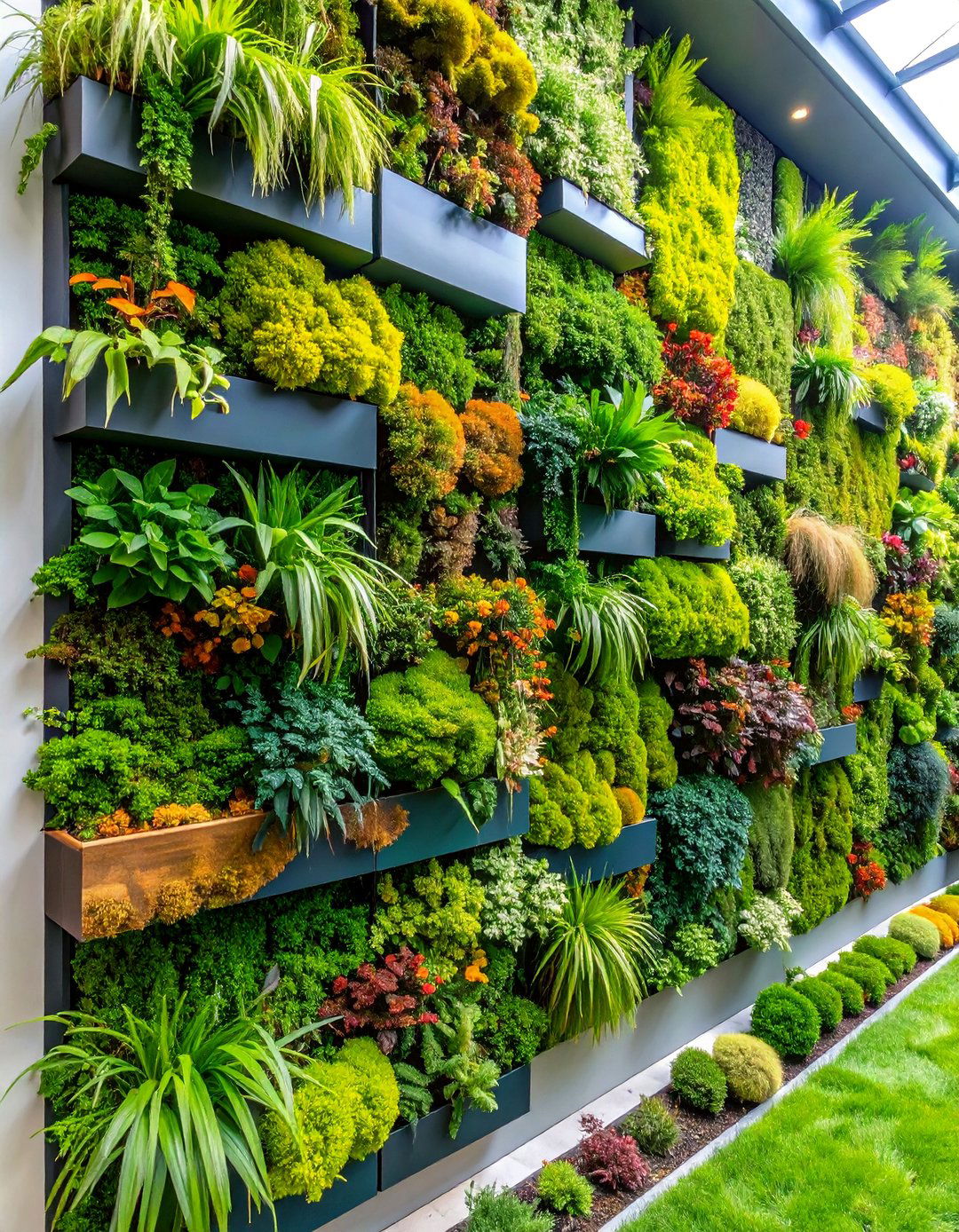
Outdoor living moss walls create stunning vertical focal points while maximizing growing space in small gardens or urban environments. Proper drainage systems prevent waterlogging while irrigation systems maintain optimal moisture levels for moss establishment and growth. Different moss varieties create textural interest and color variations across the vertical surface, with some varieties preferring different moisture levels or exposures. The wall structure requires proper support and weather-resistant materials to handle moss weight and moisture over time. These installations work beautifully as privacy screens, property boundary features, or architectural elements that soften building facades. Regular monitoring ensures proper moisture balance while seasonal cleaning removes debris and maintains moss health.
14. Moss Courtyard Garden with Central Water Feature
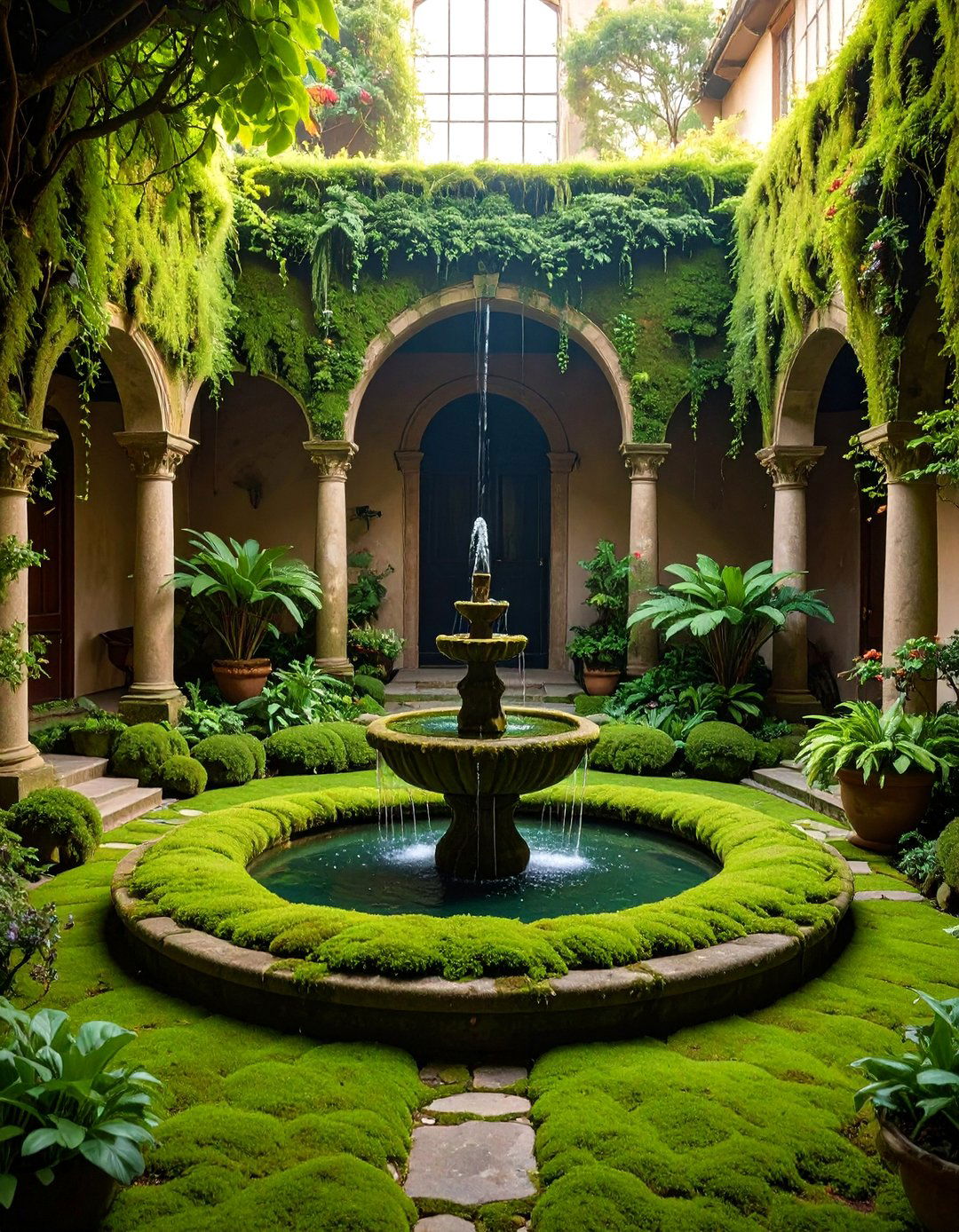
Intimate courtyard gardens featuring moss carpets and central water elements create private oases perfect for urban homes or commercial spaces. The enclosed nature of courtyards provides ideal conditions for moss establishment, with walls creating shade and protection from wind and extreme temperatures. Central fountains, small ponds, or water basins provide humidity while serving as focal points within the moss landscape. The design emphasizes simplicity and tranquility, with minimal plant varieties allowing moss and water to dominate the aesthetic. Stone or gravel accents provide textural contrast while maintaining the serene atmosphere. These gardens require attention to drainage and moisture balance but reward with year-round beauty and peaceful atmospheres.
15. Moss Rock Spiral Garden with Natural Boulder Arrangement
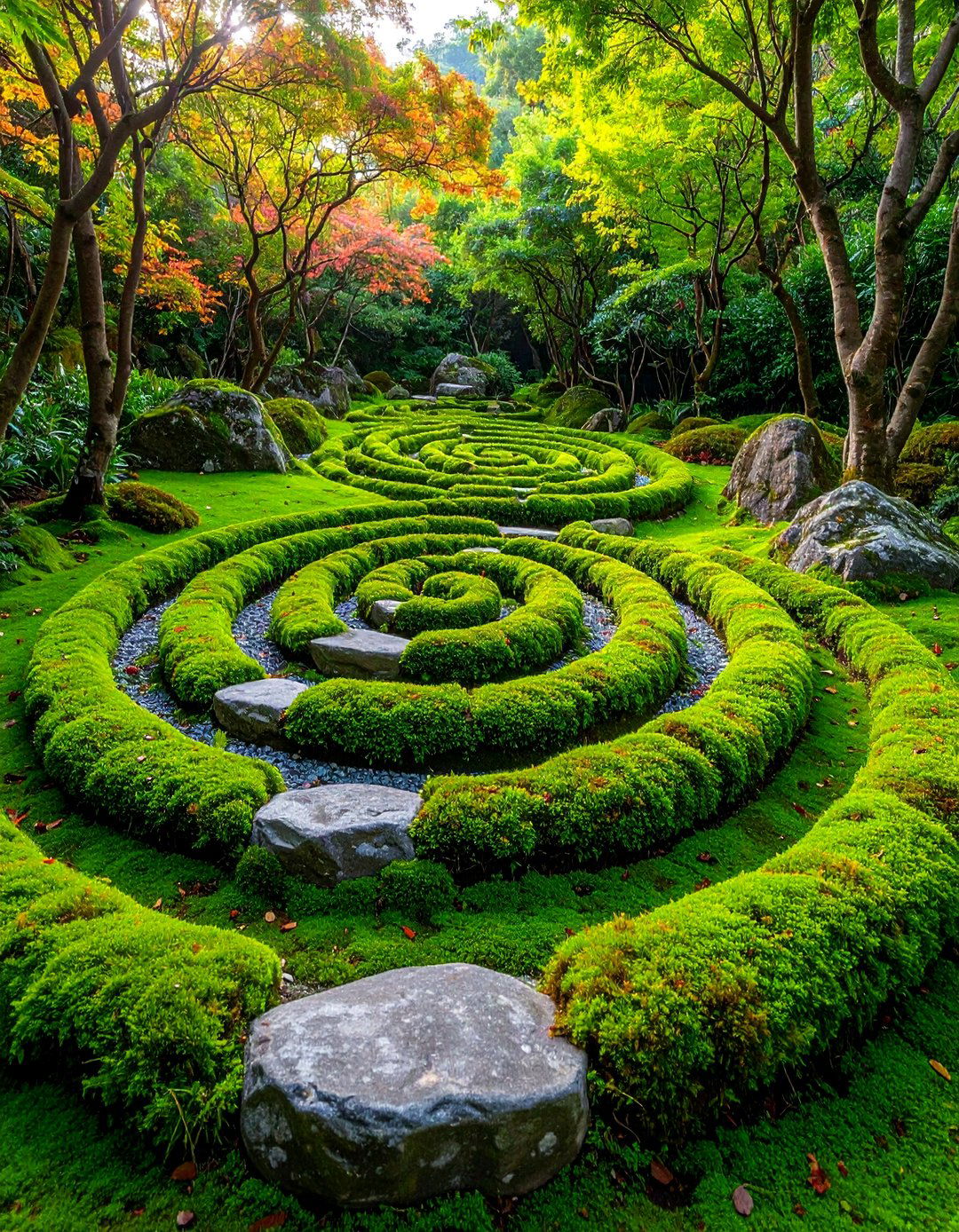
Spiral moss gardens using natural boulders create dynamic landscapes that guide movement and create visual interest through three-dimensional design. Large rocks form the spiral structure while moss fills the spaces between, softening the mineral hardness and creating unified compositions. The spiral design encourages walking meditation while providing multiple viewing angles and discovery points throughout the garden. Different elevations within the spiral create varied growing conditions, allowing diverse moss varieties to establish in their preferred microenvironments. This design works well in larger garden spaces where dramatic focal points enhance the overall landscape composition. Construction requires careful boulder placement and soil preparation, followed by gradual moss establishment over time.
16. Moss Bridge Garden with Wooden Walkway Elements
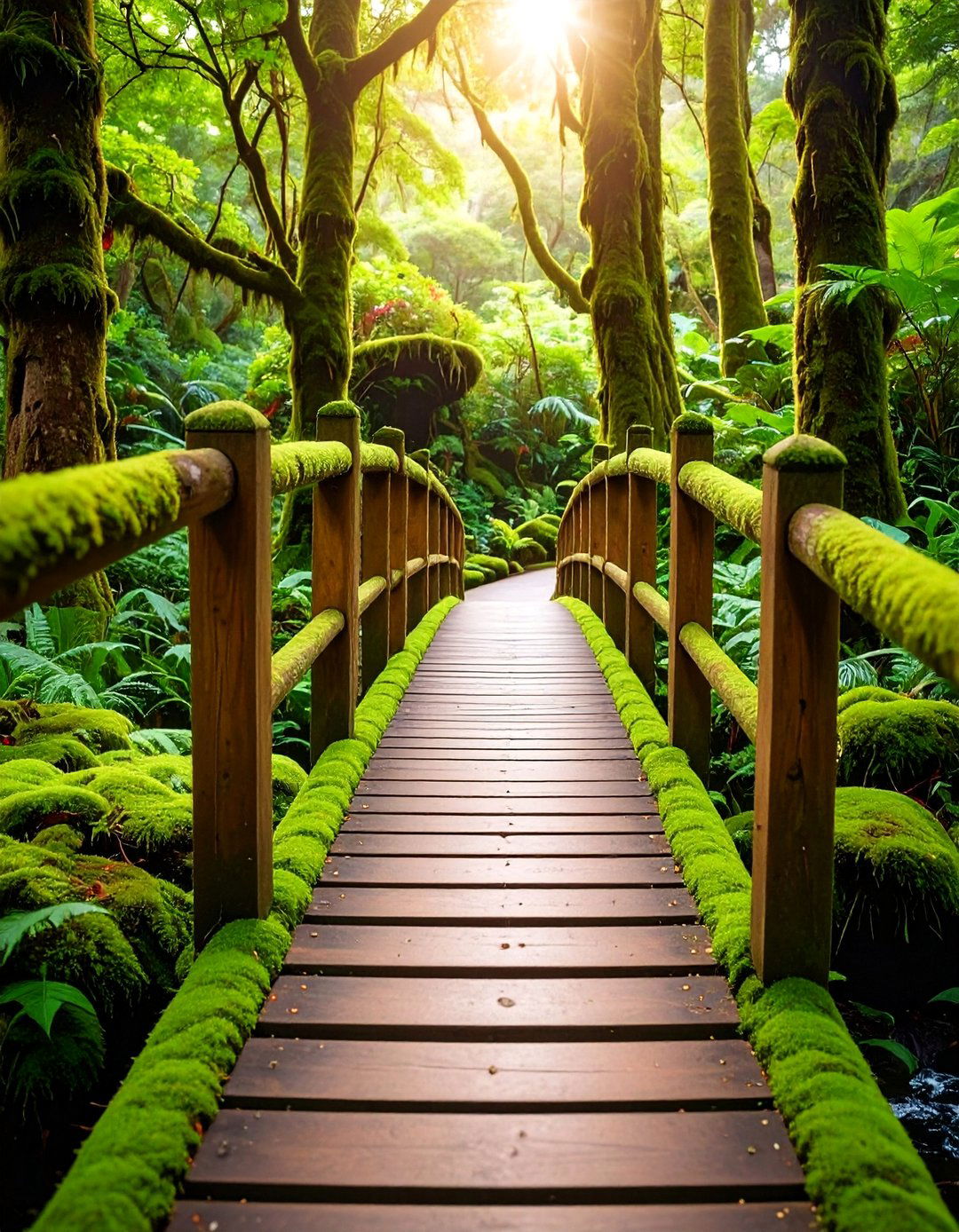
Garden bridges covered with moss create magical passage ways that connect different garden areas while providing elevated views of surrounding landscapes. Wooden or stone bridge structures provide the framework while moss colonizes surfaces over time, creating the appearance of ancient, naturally evolved passages. The elevated perspective offers new viewpoints of garden spaces while the moss softening creates gentle, organic appearances that blend with natural surroundings. These features work particularly well in gardens with elevation changes, water features, or areas where visual separation enhances the overall design. Construction requires proper engineering for safety while moss establishment benefits from consistent moisture and shade. The result creates focal points that enhance both function and beauty.
17. Moss Greenhouse Garden with Controlled Environment
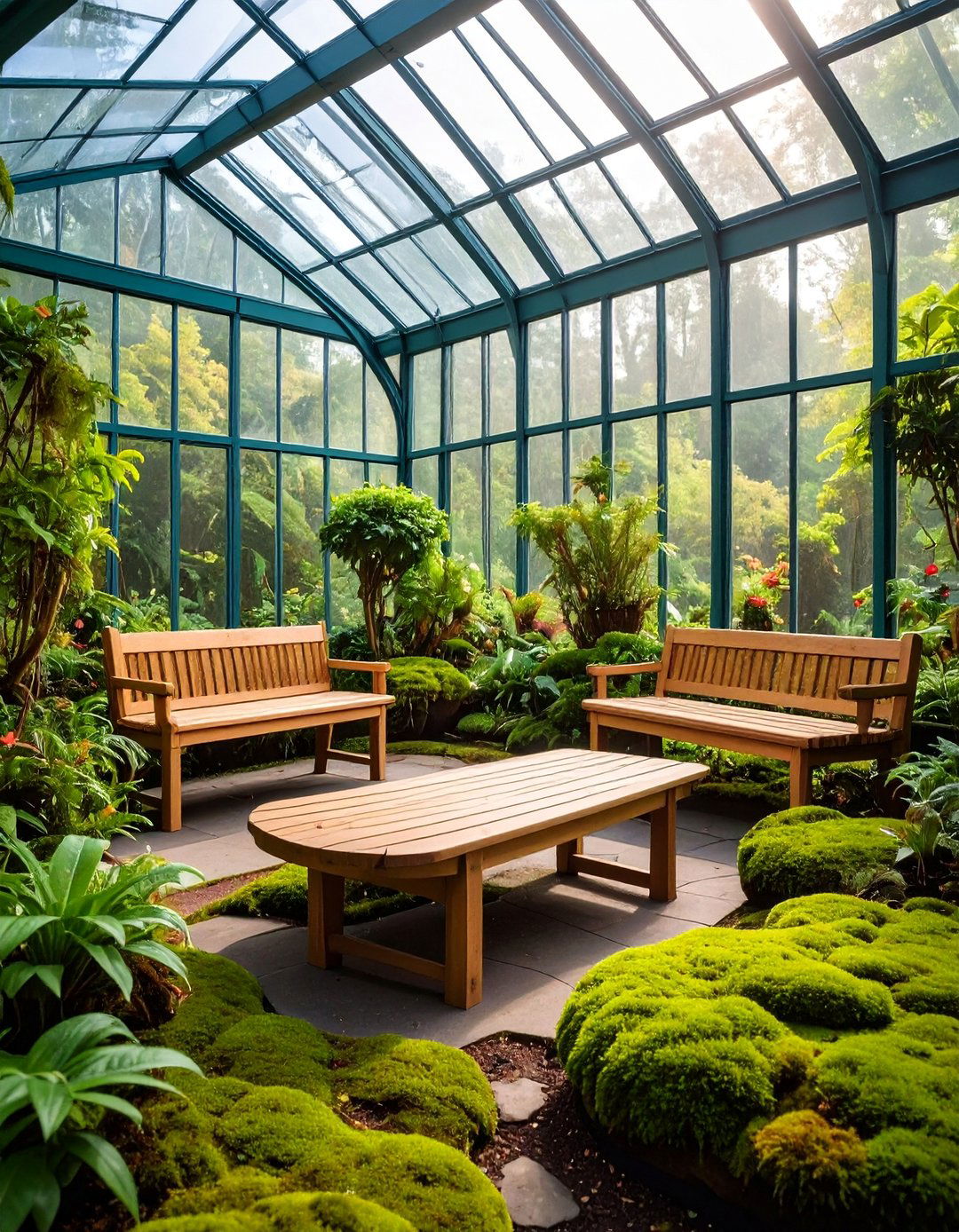
Greenhouse moss gardens create optimal growing conditions for delicate moss varieties while providing year-round garden enjoyment regardless of climate. Controlled temperature, humidity, and light levels allow cultivation of moss species that might not survive local outdoor conditions. The greenhouse environment enables experimentation with tropical moss varieties, elaborate terrarium landscapes, or propagation projects for outdoor moss gardens. Benches and pathways provide comfortable viewing areas while misting systems maintain ideal growing conditions. These spaces serve as both functional growing areas and peaceful retreats where garden enthusiasts can enjoy moss gardens regardless of weather conditions. The controlled environment requires monitoring systems but enables moss gardening in any climate.
18. Moss Roof Garden with Extensive Green Roofing
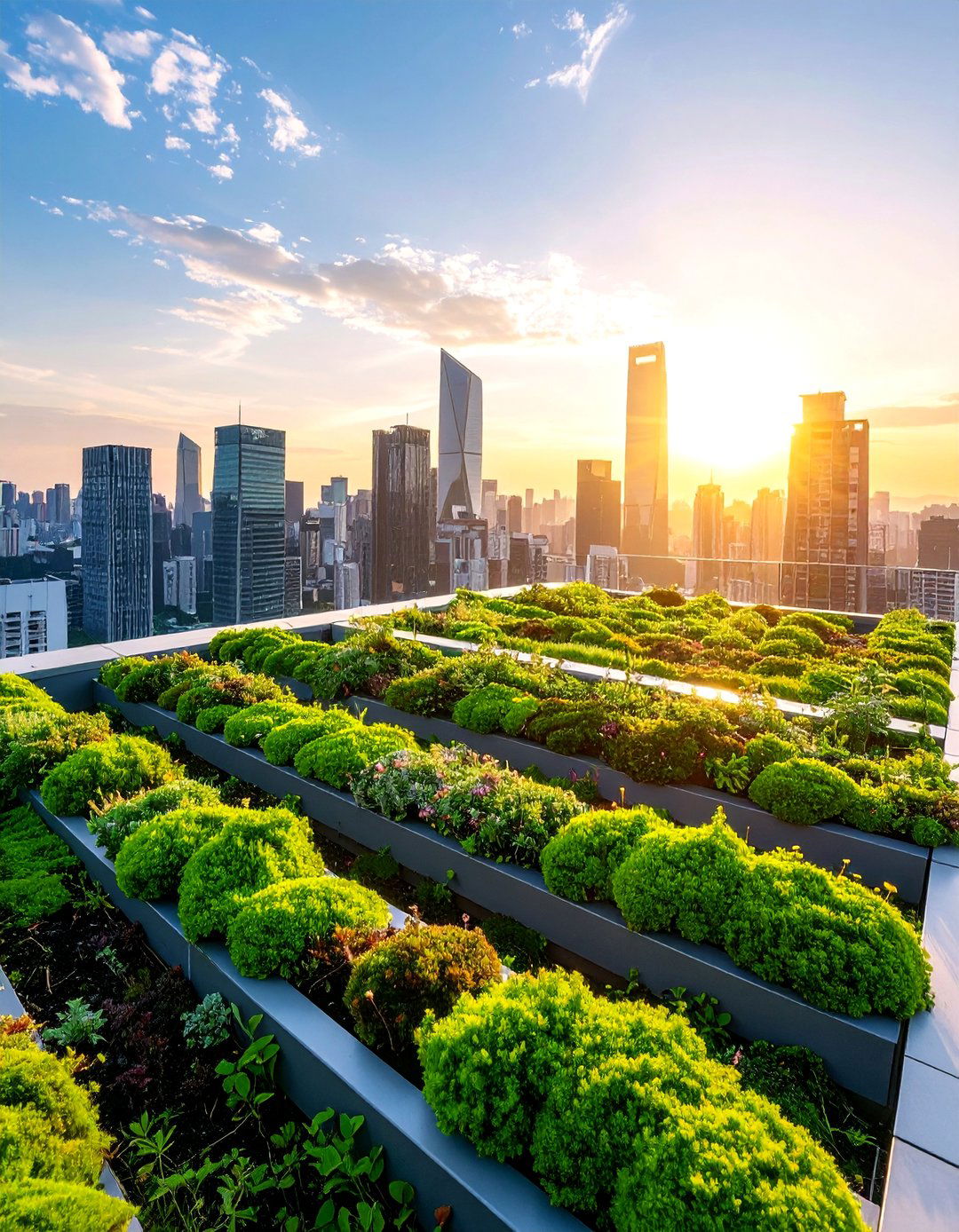
Extensive green roofs featuring moss provide sustainable building solutions while creating accessible garden spaces in urban environments. Moss varieties adapted to shallow soil and extreme conditions colonize roof surfaces, providing insulation, stormwater management, and habitat creation. The lightweight nature of moss makes it ideal for roof applications where weight limitations restrict other plant choices. Different moss varieties create patterns and seasonal color changes while requiring minimal maintenance once established. These installations require proper waterproofing, drainage, and wind protection but provide significant environmental benefits including energy savings and urban heat island reduction. The result combines practical building performance with beautiful green spaces that enhance urban environments.
19. Moss Memory Garden with Commemorative Stone Elements

Memorial moss gardens create peaceful spaces for remembrance and reflection through thoughtful combination of moss carpets and commemorative stones or markers. The enduring nature of moss symbolizes continuity and renewal while providing gentle, comforting environments for contemplation. Engraved stones, memorial plaques, or symbolic objects integrate naturally within moss landscapes, creating meaningful spaces that honor memories while supporting healing. These gardens benefit from simple, uncluttered designs that focus attention on remembrance rather than complex landscaping. The low-maintenance nature of moss ensures these spaces remain beautiful with minimal intervention, allowing focus to remain on their commemorative purpose. Such gardens provide lasting tributes that grow more beautiful over time.
20. Moss Moonlight Garden with Pale Stone Accents

Evening moss gardens featuring pale stones and subtle lighting create magical nocturnal landscapes perfect for nighttime enjoyment. Light-colored stones and gravel provide contrast against dark moss while reflecting moonlight and artificial illumination throughout the space. Strategic lighting placement highlights moss textures and creates depth without overwhelming the natural beauty. The design emphasizes subtle beauty that emerges in low-light conditions, creating entirely different experiences than daytime viewing. Pale pathways guide movement safely through the space while maintaining the mysterious, ethereal atmosphere. These gardens work beautifully near outdoor seating areas or along evening walking routes where subtle beauty enhances relaxation and contemplation.
21. Moss Winter Garden with Evergreen Framework Structure

Winter-focused moss gardens maintain beauty through cold seasons by combining moss carpets with evergreen shrubs and trees that provide structure and protection. The moss remains visible beneath snow while evergreen elements create visual anchors during dormant periods. This design ensures year-round garden interest while highlighting moss resilience in challenging conditions. Strategic plant placement provides wind protection for moss areas while creating layered compositions that work in all seasons. The combination requires careful selection of compatible plants that share similar growing requirements with moss varieties. These gardens prove particularly valuable in climates with long winters where traditional gardens lose appeal during cold months.
22. Moss Labyrinth Garden with Meditative Walking Paths

Moss labyrinth gardens create structured meditation experiences through carefully designed walking paths that encourage contemplation and inner reflection. The labyrinth pattern uses moss-covered paths separated by low stone walls or planted borders, creating clear walking routes while protecting moss from excessive foot traffic. Walking meditation through moss labyrinths combines physical movement with spiritual practice while connecting participants with natural environments. The design requires precise geometric planning while maintaining organic, natural appearances that enhance rather than compete with the meditative experience. These installations work beautifully in retreat centers, therapeutic gardens, or private spaces dedicated to wellness and spiritual practice. Construction involves careful attention to path width, moss variety selection, and maintenance access.
23. Moss Alpine Garden with Mountain-Inspired Rock Features

Alpine-style moss gardens recreate mountain environments through strategic rock placement and moss varieties that mimic high-elevation landscapes. Boulder arrangements suggest mountain peaks while moss varieties adapted to harsh conditions create realistic alpine meadow effects. The design captures the rugged beauty of mountain environments while functioning in various climate conditions through careful plant selection. Drainage considerations become critical in alpine designs, ensuring moss receives adequate moisture without waterlogging. These gardens work particularly well in areas with natural slopes or where dramatic landscape features enhance property values. The combination of hardy moss varieties with striking rock formations creates low-maintenance landscapes that provide year-round interest and mountain-inspired beauty.
24. Moss Secret Garden with Hidden Entrance Pathways
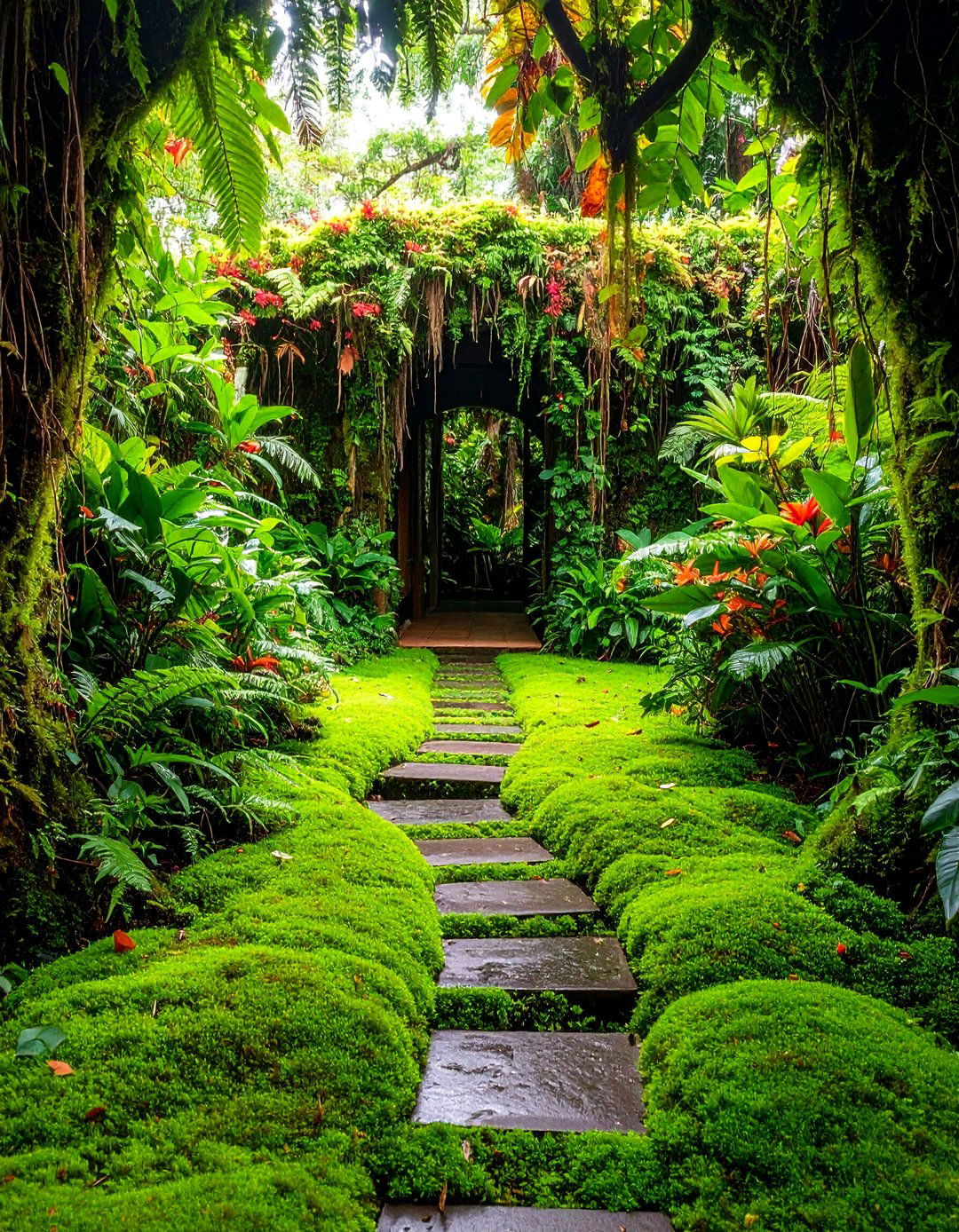
Hidden moss gardens accessible through concealed entrances create private retreats that offer escape and discovery within larger landscape compositions. Careful design conceals garden access through strategic planting, walls, or natural features while moss carpets reward visitors with unexpected beauty. The sense of discovery enhances the garden experience while providing truly private spaces for relaxation and contemplation. These designs work well in larger properties where space allows for separate garden rooms or in urban settings where privacy becomes paramount. The moss provides peaceful ground cover that maintains beauty with minimal maintenance, allowing focus on the overall design experience. Hidden gardens benefit from surprise elements and careful attention to access routes that enhance rather than detract from the discovery experience.
25. Moss Artistic Sculpture Garden with Living Art Elements

Contemporary moss gardens incorporating sculptural elements create outdoor art galleries where living moss interacts with permanent art installations. The moss provides organic contrast to metal, stone, or wood sculptures while creating unified compositions that change seasonally. Artists and landscape designers collaborate to create pieces where moss becomes integral to the artistic vision, growing over and around sculptural elements over time. These installations demonstrate moss versatility in contemporary art applications while providing low-maintenance landscape solutions. The interaction between living moss and permanent art creates dynamic compositions that evolve continuously, ensuring these gardens remain interesting and engaging over time. Such gardens work beautifully in public spaces, museum grounds, or private collections where art and nature converge.
Conclusion:
Moss gardens offer endless possibilities for creating peaceful, sustainable landscapes that thrive where traditional gardens struggle. From intimate terrariums to expansive outdoor installations, moss provides year-round beauty with minimal environmental impact. These ancient plants adapt to various design styles, from Japanese zen aesthetics to contemporary art installations, proving their versatility in modern landscaping. Whether seeking meditation spaces, artistic expressions, or practical lawn alternatives, moss gardens deliver lasting beauty that grows more enchanting over time. The low-maintenance nature combined with exceptional resilience makes moss an ideal choice for sustainable garden design that connects us with nature's enduring beauty.




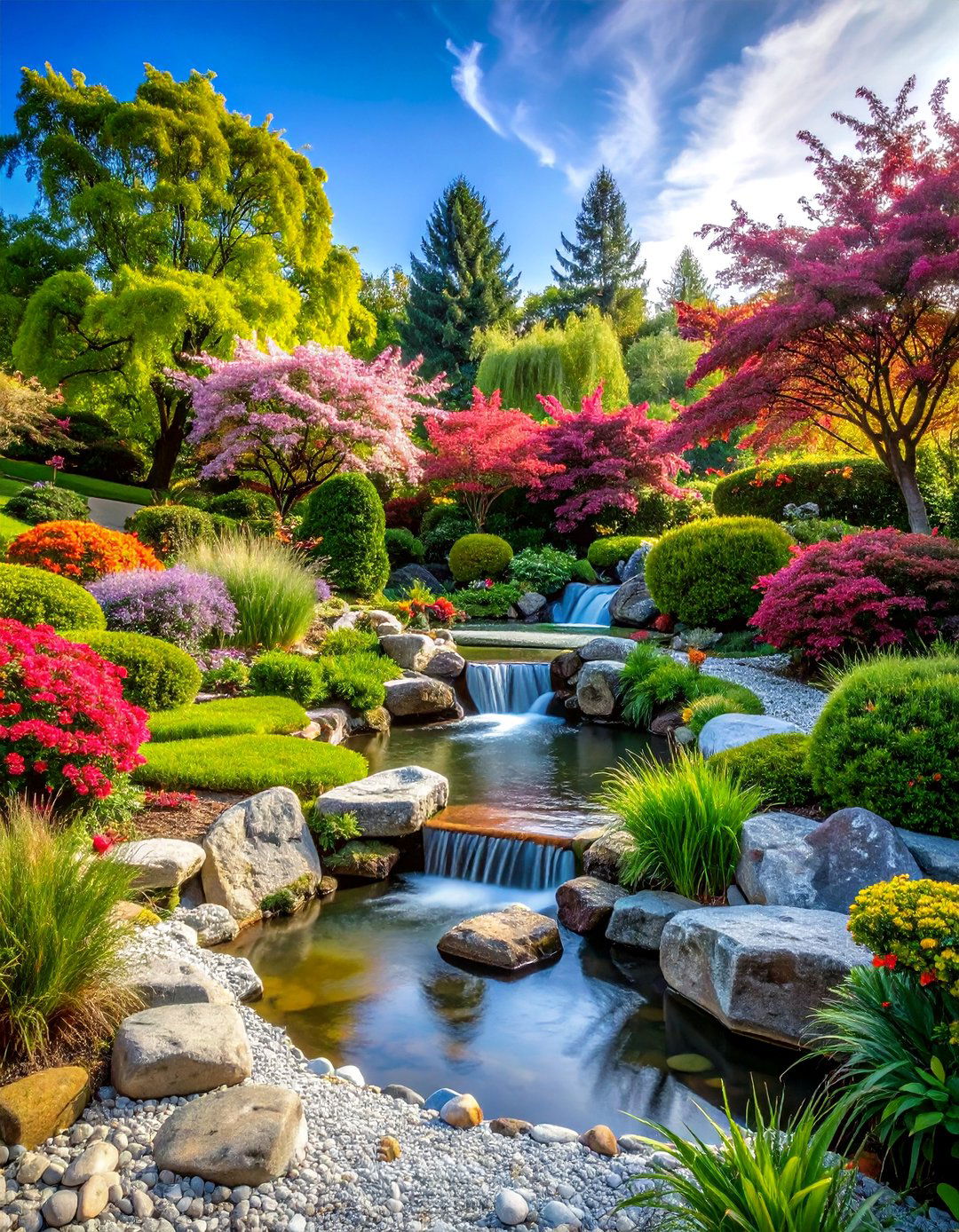
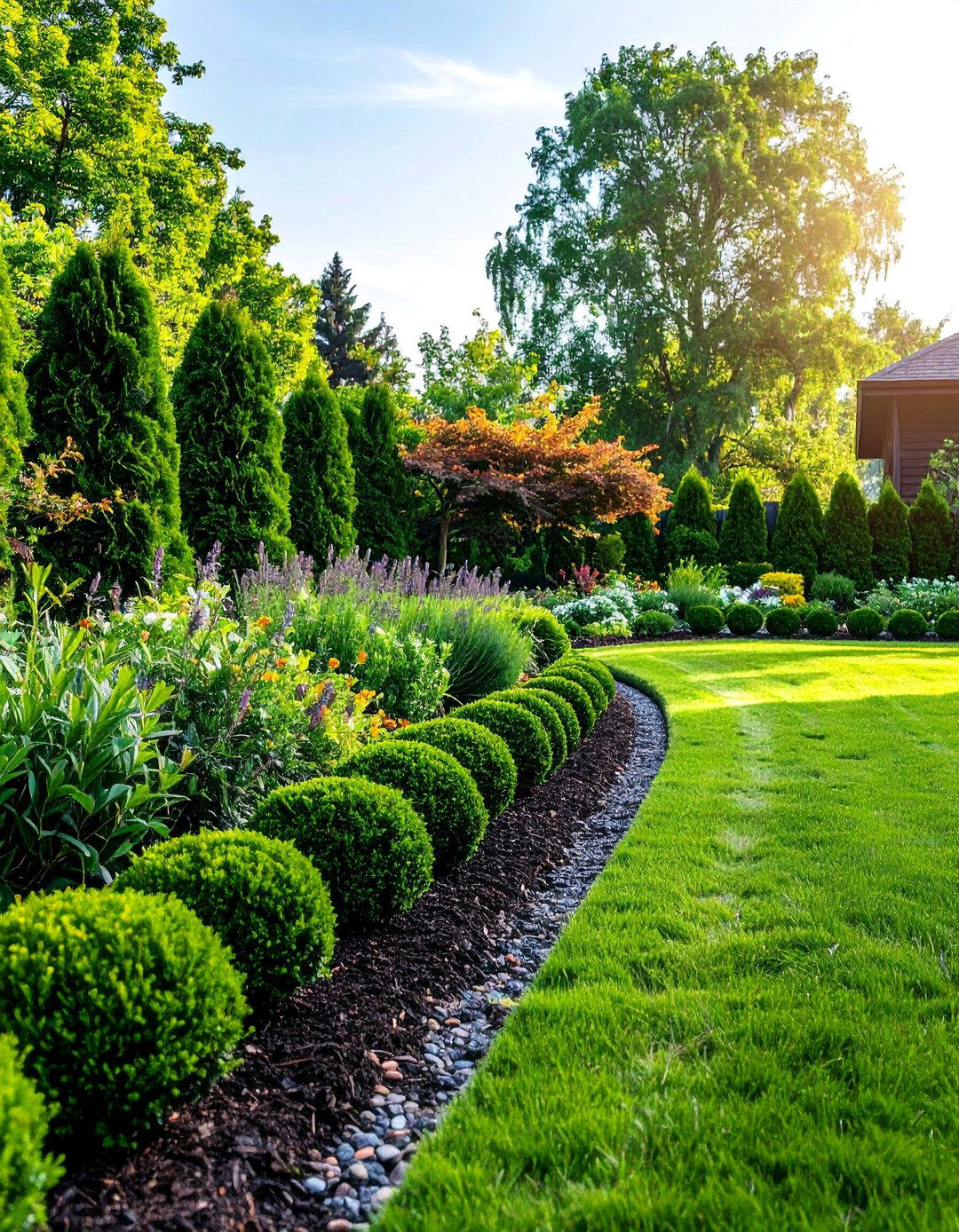
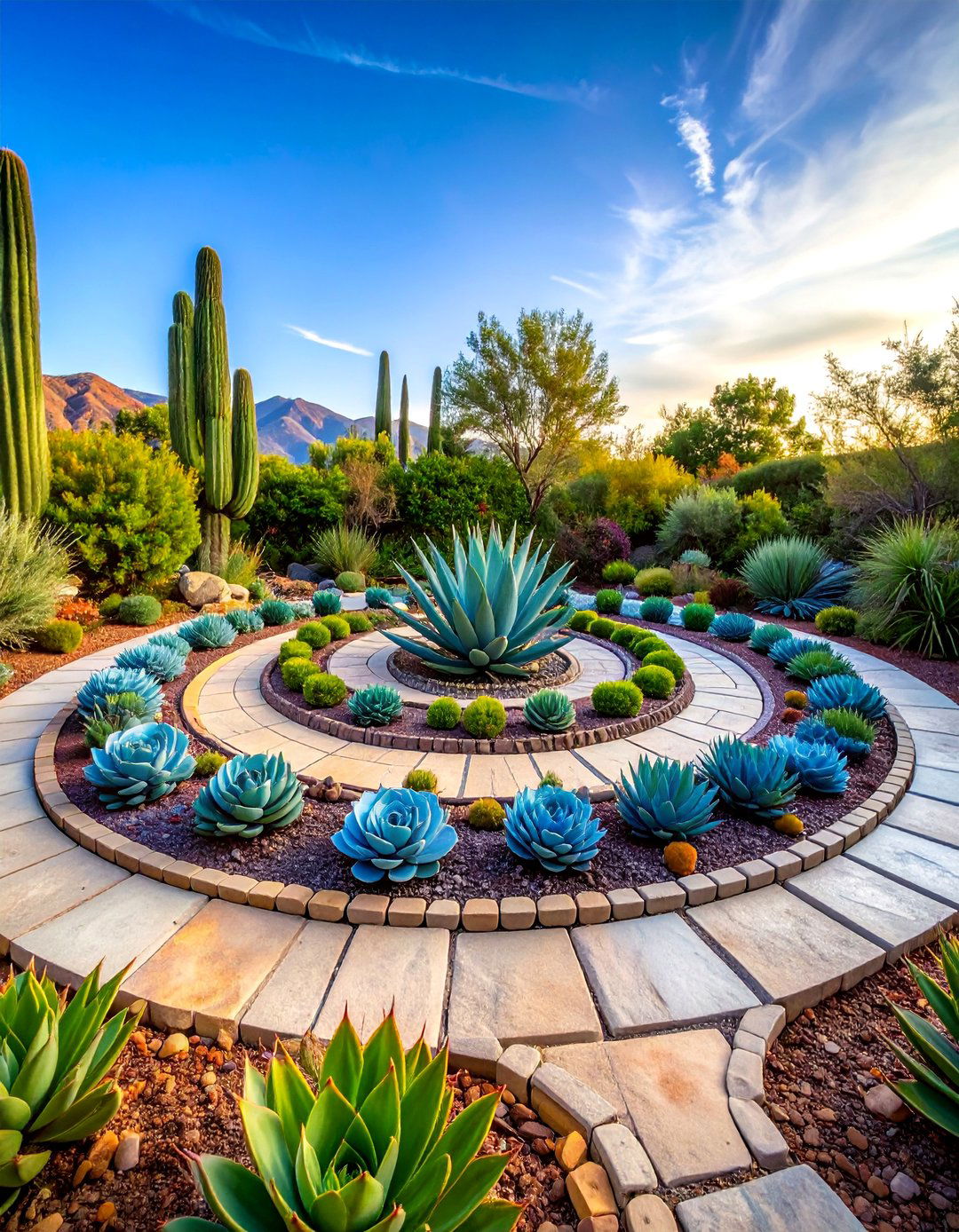

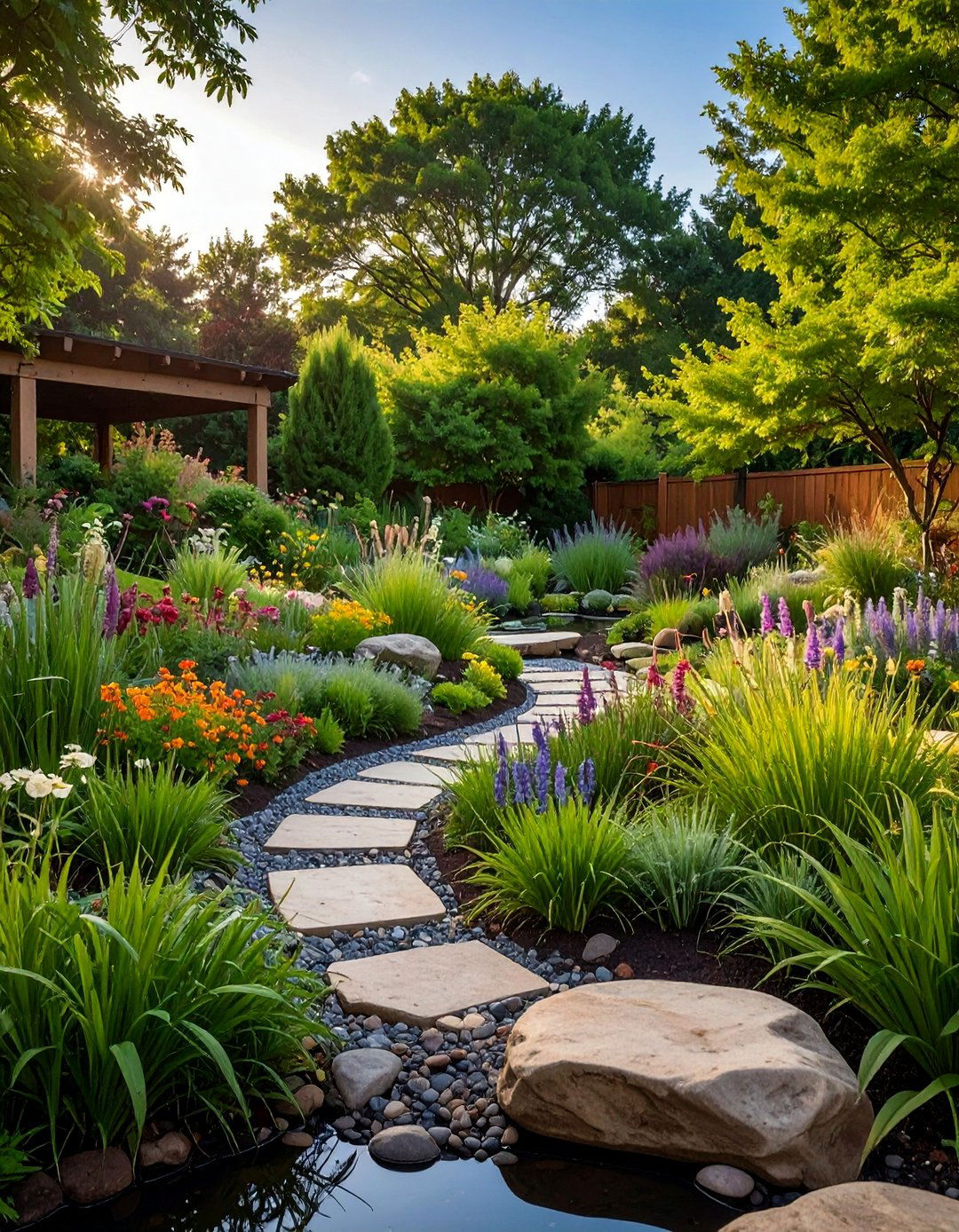
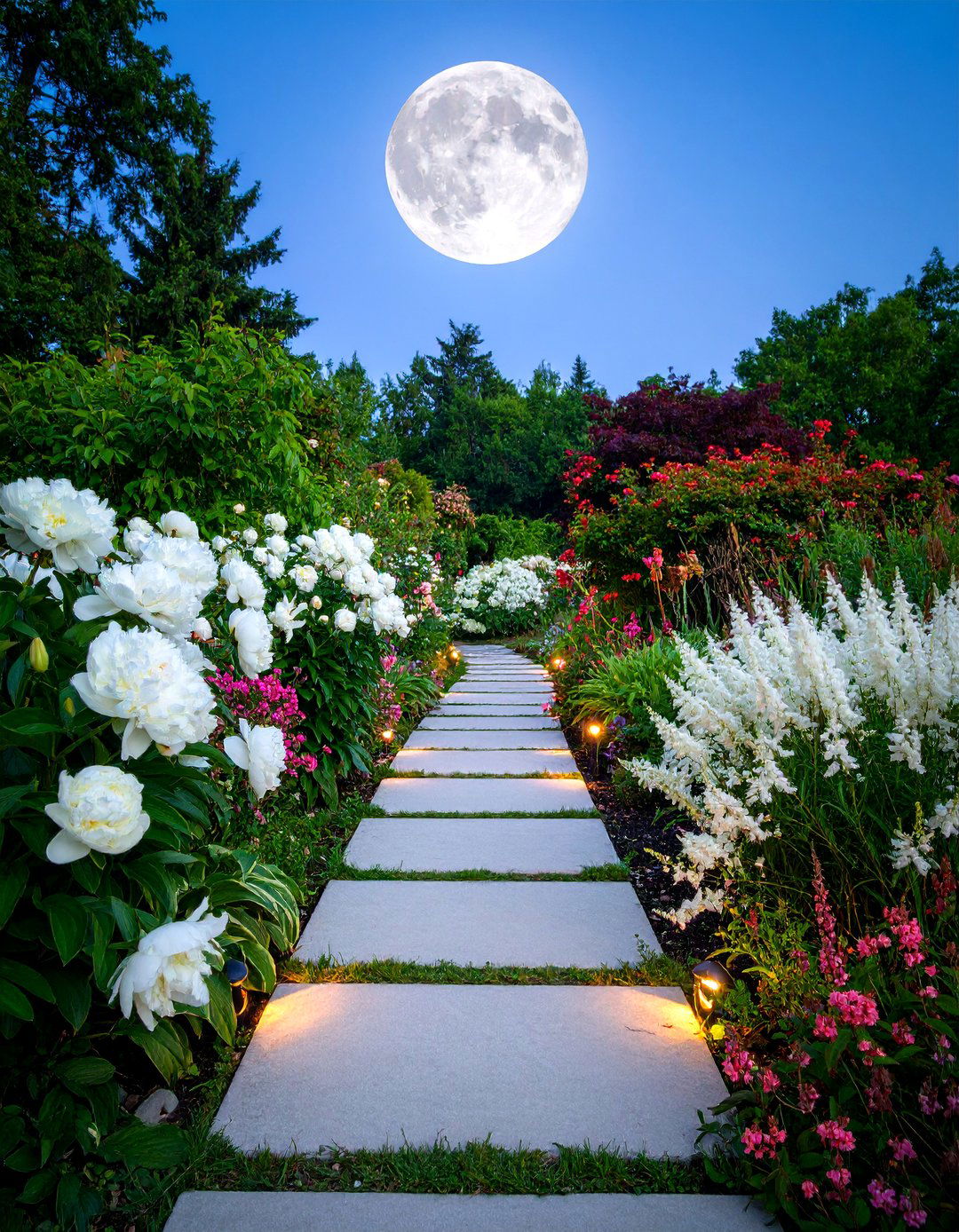

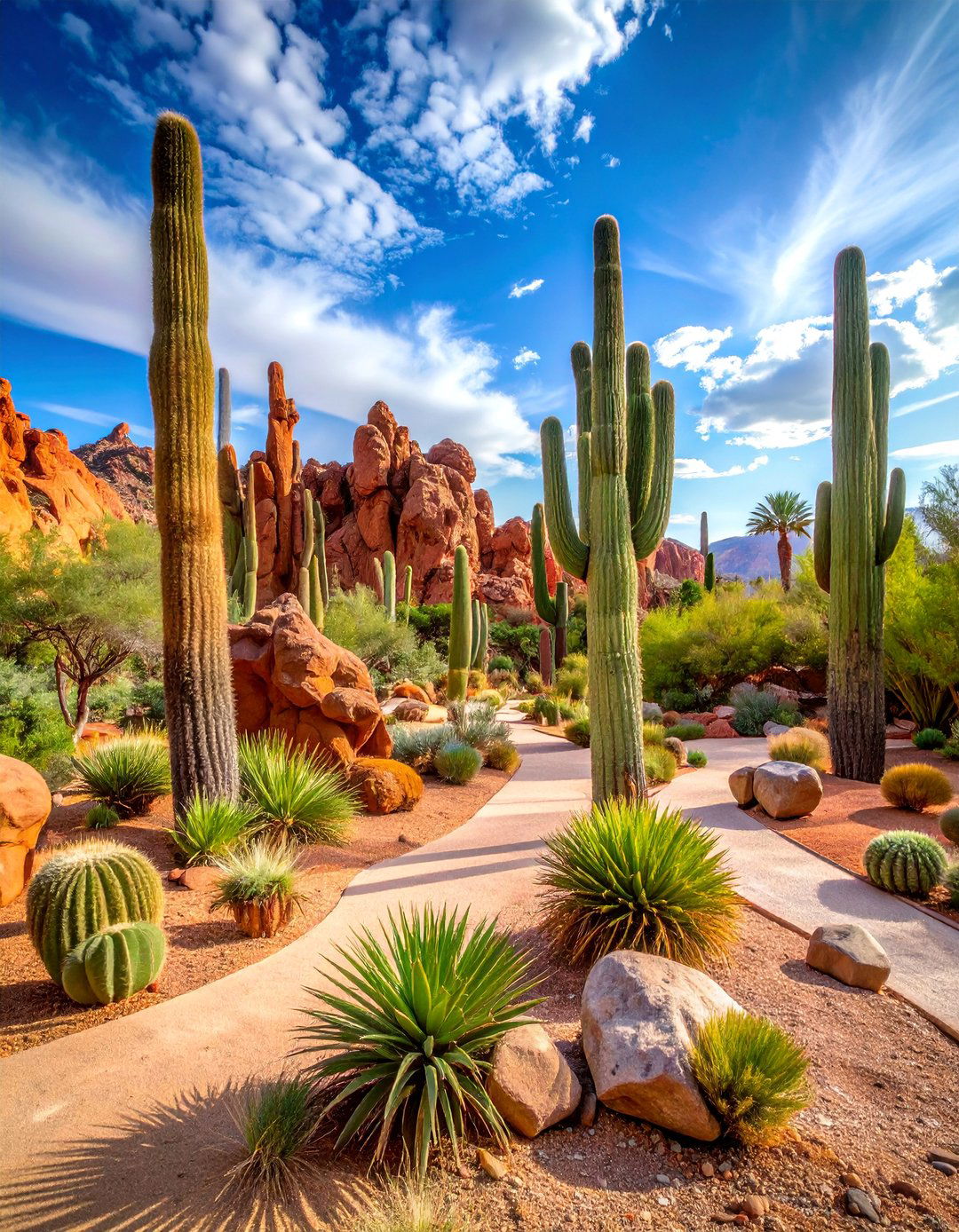




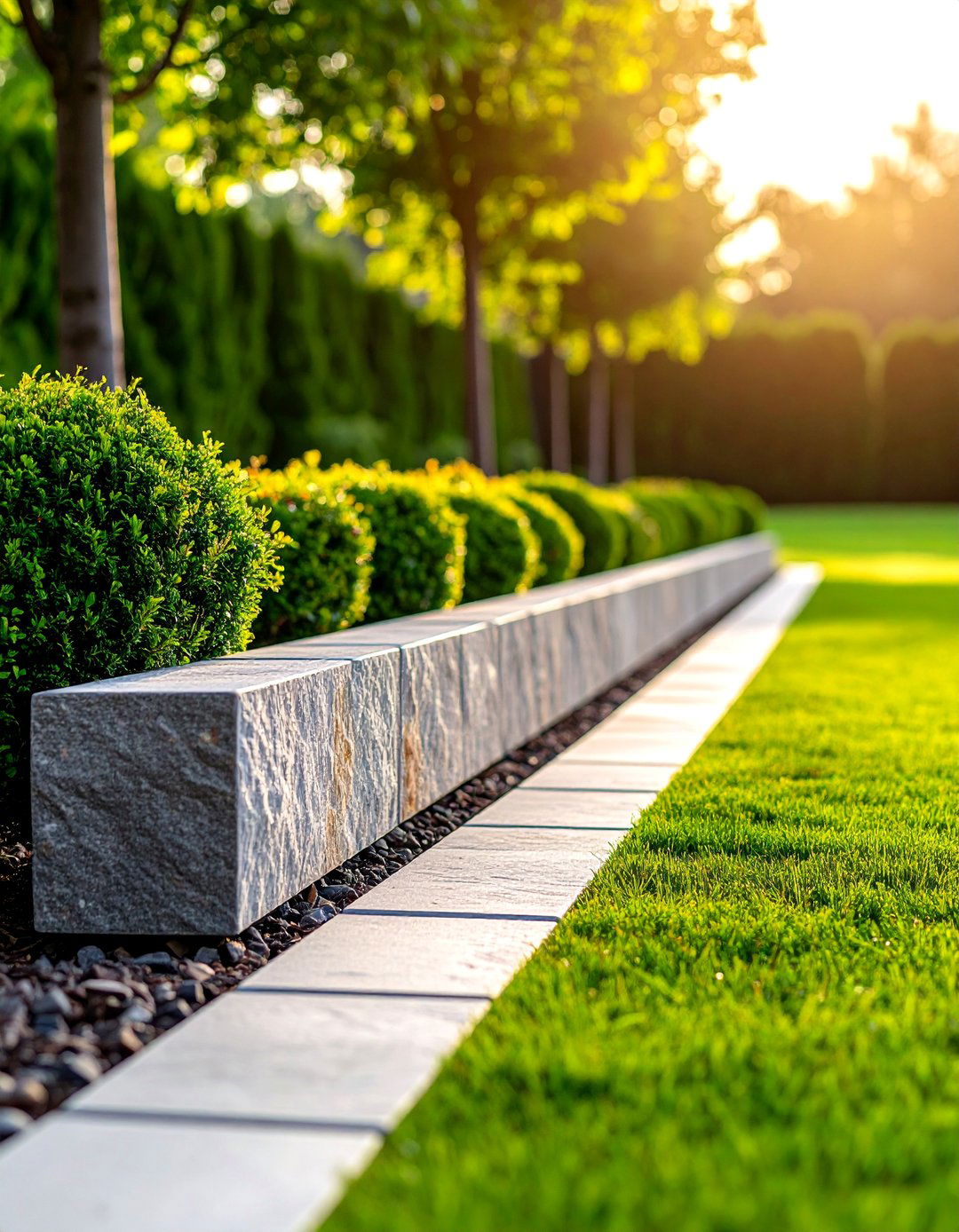

Leave a Reply